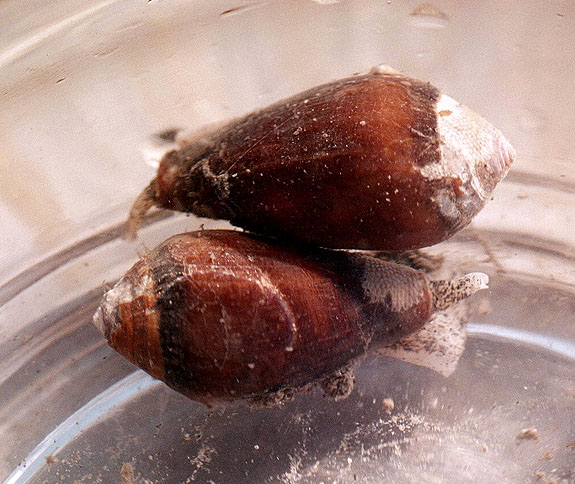
Wrigley Marine Science Center, Catalina Id. – May 10, 2003
The California cone snail, Californiconus californicus, prefers to eat living gastropods but it also preys on a greater variety of animals than does any other cone snail species whose diet has been characterized (Kohn, 1966). It has a diverse diet even though, like other members of the genus, it has a highly specialized radula (Marshall et al., 2002). This probably has to do with being the only species in California, whereas there are about 30 species of Conus in Hawaii (for example), each feeding on a narrow range of food types. However, like other Conus spp., it can prey on fish (see Stewart & Gilly, 2005), even if its conotoxins are not vertebrate-specific (and potentially fatal to humans) as in fish-eating specialists. It is also unusual in being diurnal in its activities, whereas most other cones are crepuscular (Costa, 1996).
Links: 1 -
2 -
3 -
4 -
5 -
6
•Costa, F.H.A. (1996) Natural history and evolution patterns in Conus californicus Hinds in Reeve, 1844. La Conchiglia, Jan-March, pp. 44-52.
•Kohn, A.J. (1966) Food specialization in Conus in Hawaii and California. Ecology 47: 1041-1043.
•Marshall, J., W.P. Kelley, S.S. Rubakhin, J.-P. Bingham, J.V. Sweedler and W.F. Gilly (2002) Anatomical Correlates of Venom Production in Conus californicus. Biol. Bull. 203: 27-41.
•Olivera, B.M. (1997) Essay E.E. Just Lecture, 1996 - Conus Venom Peptides, Receptor and Ion Channel Targets, and Drug Design: 50 Million Years of Neuropharmacology 8: 2101-2109.
•Stewart, J., and W.F. Gilly (2005). Piscivorous Behavior of a Temperate Cone Snail, Conus californicus. Biol. Bull. 209: 146-153.
Return to Catalina Image Index or Fieldtrip Map or Biology 317 Homepage
Image by D.J. Eernisse © 2003